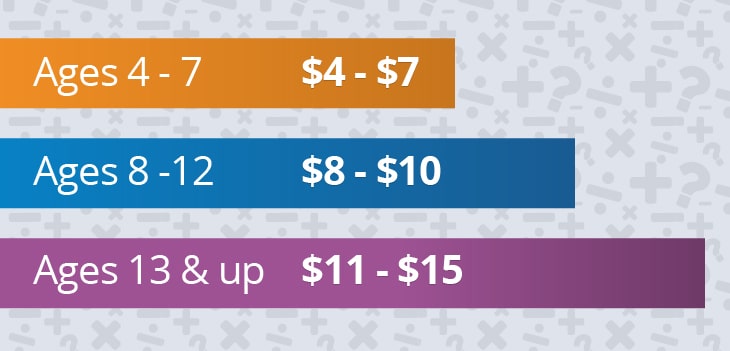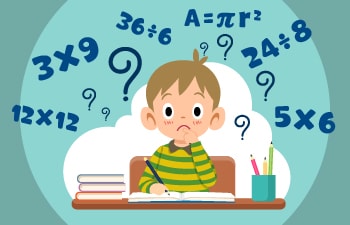Did you know April is Math Awareness Month? Well, I sure didn’t until about two months ago when I was looking for ways to reverse homeschool burnout (yes that pesky time of the year has caught us completely off guard). While I was searching for ideas, I came across a quote from Beth Kobliner. She’s an author of the New York Times bestseller Get a Financial Life, and a member of the President’s Advisory Council, and she said:
“The sooner parents start taking advantage of everyday teachable money moments (for example, give a six-year-old $2 and let her choose which fruit to buy), the better off our kids will be. Parents are the number one influence on their children’s financial behaviors, so it’s up to us to raise a generation of mindful consumers, investors, savers, and givers.”
Being relatively new to homeschooling, this got me thinking, “how can I make math more fun for my kids”? How can I teach them basic money skills at such a young age, while also making it fun for them?
One thing is for sure, and that is I don’t want them to end up being part of the two-thirds of American adults who can’t even pass a basic financial literacy test. (Yep, I recently read a study called the National Capability Study and found that a large number of adults got fewer than four answers correct on a five-question quiz). The whole reason I chose to homeschool in the first place was to provide my kiddos with a quality education. And I’ve got the power to make it happen. All I needed was a few new ideas to bring back the enthusiasm to my homeschool.
Math Awareness Month Activities
In honor of Math Awareness month, I planned these activities to show my little ones how we incorporate math in our everyday lives. Feel free to try them with your kids:
- Calculate the tip in a restaurant. If you have more than one child (like I do), you can play with the percentages and ask each child to calculate a different percentage. You can even rate the service and debate with your child which percentage tip to give out. Once they’ve calculated the percentage, have them fill out the amount and then do the math for the total.
- Need cash from the ATM? Some ATM machines dispense $20, $50 and $100 bills. Have your child add up how many of each bill will come out of the ATM machine to complete the total amount you requested. This one is especially good to brush up on their math facts!
- Is there a birthday coming up? A special dinner or family gathering? I usually create a budget with my children and have them keep track of what it costs to feed everyone, buy the decorations, and any party favors needed for the celebration.
- Never too early to budget for the holidays. Create a holiday gift shopping budget. I’ve asked my children what gifts they would like to get for Christmas and calculate the total cost. Once they know the total cost of everything they want, I have them calculate how much money needs to be put aside on a monthly/daily basis to meet that target.
- While setting up budgets is fun and super helpful to teach children about the costs involved in things on our everyday lives, where does the money come from? I have my children calculate how much of their allowance needs to be put aside to contribute to the holiday and birthday presents shopping list. I’ve even had them think about what side jobs or summer jobs they can take on to meet that target (babysitting, pizza delivery, tutoring, etc).
- We have 2 dogs and a cat. So, I started having my children keep track of what it costs to feed and care for them. This gives them a good idea of how much money it costs to have pets if they want one in the future.
- I almost never create a shopping list for the grocery store, which is not recommended, but when I do remember to create one, I try to stick to it. I give my children the budget that they are to work within and have them calculate the items on the list they will be able to purchase based on the budget. Depending on the item, brand, and price, they select the item. They soon figure out that they may be able to get an additional item from the list if they are cautious with their spend.
- Since my children are in middle and high school I’ve taken things a bit further and asked them to keep track of all the expenses at home. Utility bills, groceries, gas, and entertainment. You can add even more the list, like mortgage, car payments etc, I just kept it simple (for now). Once they have the numbers at the end of the month, I have them create pie charts to visualize what percentage of our expenses goes towards each category.
Build a solid math foundation with Time4MathFacts and help students gain thorough understanding of math concepts with Time4Learning’s online math curriculum!
Give Your Children an Allowance
I recently came across a report by researchers at the University of Cambridge, commissioned by the United Kingdom’s Money Advice Service, revealed that kids’ money habits are formed by age 7. So, the sooner you start teaching them about money, the better equipped they will be for their financial future. And an allowance is a great way for children to learn about money.
Once chores were completed for the week, I gave my kids cash for their hard work. There’s nothing like handing over your cash for something and watching it disappear -especially with the younger ones. Financial educator Roslyn Lash says: “Cash will give (kids) a real-life illustration of how fast money goes and how they need to be conscious of spending.”
A survey by RoosterMoney found that kids ages 4 to 14 saved an average of 34.9% of their allowance. Before you decide on an amount, set some guidelines. For example, you should both understand what the allowance will cover: School lunches? Snacks? Computer games? Extracurricular activities?
For older children, big ticket items such as a car or college could be their goal. Write down what they are saving and spending or use an app so they can budget and track their spending habits. Then there is the question about whether or not your child should work for their allowance. I typically give my children an allowance of $10 a week and allowance is strictly tied to chores and rules adherence in my house. For a general view on what other parents pay their children, review the following chart.

Using the chart above, a four-year old who saves $1.50 of their allowance each week will have earned $36 in six months. A 14-year-old who saves $6 a week out of their $12 allowance will have earned $144 in six months. The more they save, the better chance they have at buying something that they have their eye on. It’s simple math, a great financial lesson, and it teaches patience.
Remember, you’ll not only be teaching your children math skills, you’ll also be providing them real-life lessons on financial awareness and money management. And that’s something they’ll carry with them for their entire lives.
Allowance Savings Worksheet
Use this Homeschool.com printable worksheet to teach your kids how to budget their money and manage their finances.
Learn tricks and strategies to help support students struggling in math!










